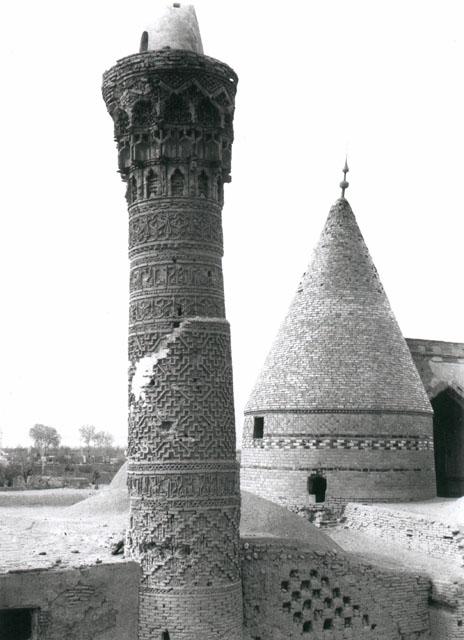its towers like Kentish oast-houses
After having spent in Mashhad the days around Christmas, on the entry dated 9th of January 1934, we find Byron further West: in Bastam. There, the first monument Byron encounters and notes down in his travelogue is the Mashhad-i Bayazid Bastami. January 1934 corresponds to the month of Ramadan. In this entry, Byron underlines the period of the year through a conversation (probably made up, since he could not speak either Arabic or Farsi) with the Chief of Police.
“I was arrested […], but the Chief of Police was amiable enough when I produced my documents. I explained that much as I sympathized with the habit of turning night into day during Ramadan, it could not profit me to adopt it, in my search for monuments. He assented – rather shamefaced.”

Robert Byron sounds amazed by the decoration of the shrine of Bayazid Bastami. He compares it with the decoration he found in Hamadan (the one on the Gunbad-i ‘Alaviyyan, that he compared to Versailles), but in this case, he finds it not as exuberant, “[b]ut it has the same virtues of splendour without ostentation and intricacy without incoherence”.
Bayazid Bastami was a mystic, originally from the town of Bastam. According to the remains, apparently, the construction of his shrine started soon after his death. Nevertheless, various periods of construction (and restoration) can be detected. The oldest elements of the building date back to the Seljuk period: the remains of the minaret and part of the wall, now incorporated into the existing mosque, bear a foundation inscription that gives the date 514 A.H. / 1120 A. D.

Repairs and other construction works were undertaken during the reign of Ghazan Khan (r. 1295-1304), precisely dated by an inscription on the mihrab to 1299. After that, other works were carried out under the reign of Uljaytu (the one of the Dome of Sultaniyya), thus between 1304 to 1316.
In the inscriptions of the Shrine of Bayazid Bastami, we can find the name of the craftsmen that carried out the construction works. This is something already encountered in the epigraphic bands of the Musalla of Mashhad: a feature that is not rare in Iranian monument, but nonetheless very peculiar.

In the case of the Mashhad-i Bayazid Bastami is even more noteworthy: the construction works were carried out by the craftsmen of a single family. As Sheila Blair notes “[t]he al-Damghani family, comprising Muhamad, his brother Hajji and their father Husayn b. Abi Talib, all signed work on the shrine of Bayazid Bastami.’ Hajji al-Damghani, in particular, also signed the mosque of Damghan. It is then possible that the family, that resided in Damghan and worked there, was recruited for the construction of the shrine in Bastam (which is about 85 km away from Damghan).
It is fascinating how so many monuments that Byron visited during his long journey end up being connected in one way or another. And it is amusing seeing that Byron visited them all, and maybe missed some of these connections.

Bibliography
Photos and technical information over the Shrine can be found on archnet.org.
Sheila S. Blair, Islamic Inscriptions, Edinburgh University Press, Edinburgh 1998, p. 51.
Arthur Upham Pope and Phyllis Ackerman (eds.), A Survey of Persian Art from Prehistoric Times to the Present. Vol. 3, Architecture, Its Ornament, City Plans, Gardens, 3rd ed., Soroush Press, Tehran 1977, pp. 1080-1084.
2 Comments Add yours